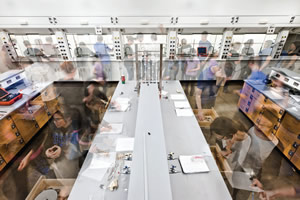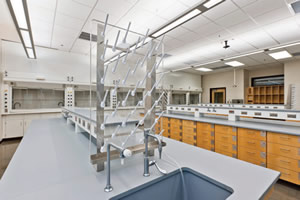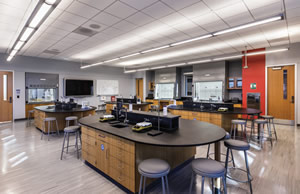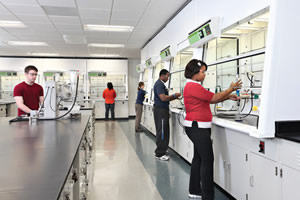Designing for Research

PHOTO © FRANK DÖRING PHOTOGRAPHY
At the outset of any research building project, the design team must work with the stakeholders to reconcile a multitude of priorities and competing goals before proceeding with design. Not that long ago, goals for environmental stewardship and operational efficiency for many institutions were rather ambiguous. The U.S. Green Building Council has developed rigorous voluntary goals for both materials and mechanical/electrical/plumbing (MEP) systems performance. Additionally, code authorities have enacted requirements for MEP systems with performance expectations that escalate over time.
It is important that expectations for materials and MEP systems performance be established as soon in the design and construction process as possible. It is equally important that all stakeholders understand and accept these expectations, both during design and construction, and as the finished building is occupied and used.
Choosing the Right Materials
While durability is still a prime consideration for materials selections in labs, availability of new materials, environmental considerations, life-cycle costs, ergonomics and changing needs of the science itself are influencing how materials are selected. Materials having some of the most significant impact on lab design are detailed here.
Flooring
Flooring should provide some degree of user comfort and contribute to the overall aesthetics of the labs, in addition to resisting damage from foot traffic, heavy loads, and chemical spills.
- Vinyl composition tile (VCT) is suitable where first cost is the main driver. Its numerous seams can support microbial growth if not properly maintained. VCT can be recycled.
- Low- or no-VOC concrete stains and epoxy sealers allow sealed concrete a wide range of aesthetic effects with good chemical resistance. Slip resistance is a consideration, and concrete is not very comfortable underfoot for long periods of time.
- Vinyl, rubber and linoleum sheet have good chemical resistance, and seams can be chemically welded to create an impermeable surface. Rubber and linoleum are more expensive, but life-cycle costs are more favorable. All three are recyclable.
- Poured- or troweled-in-place epoxy flooring systems create seamless, watertight barriers, but are generally restricted to areas that have special requirements for cleanliness and/or durability, such as glasswashing facilities or pilot plants.
Wall Finishes
Wall finishes should be selected to withstand the types of use (and abuse) and cleaning procedures expected in each lab.
- Latex enamel paint is inexpensive, but is suitable only for dry labs and wet labs where walls will not be wiped or washed down.
- Epoxy enamel paint is appropriate for “wipe-down” labs. It is more expensive than latex enamel, but more durable as well.
- Multicoat epoxy coating systems are used when chip- or scratch-resistance is necessary, and/or where rooms will be wiped or washed down, such as animal labs, glasswash facilities and containment labs. Systems may include varying numbers of layers, fiberglass mesh reinforcement or clear topcoats.
- Fiberglass-reinforced polyester (FRP) panels are used in clean labs, containment labs and animal facilities. Panel types range from single layers of FRP field-glued over other substrates to freestanding composite panels with structural cores.

PHOTO © FRANK DÖRING PHOTOGRAPHY
The light gray epoxy countertops at Eastern Kentucky University’s Science Building not only reflect light to make the room brighter, but also reduce eye fatigue.
Countertops
Countertops need to resist chemical and physical damage, but lighter-color tops have been found to help reduce lighting load, improve visual acuity in some applications and provide more pleasing aesthetics.
- Epoxy resin resists damage by moisture, solvents, heat, acid and abrasions. Cost is reasonable and, unlike other materials, it is repairable. Lighter colors generally cost more than standard black.
- Ceramic tops are relatively new to the U.S. Chemical resistance is similar to epoxy (with some exceptions), and ceramic is more resistant to physical abuse. Its higher initial cost is offset by longer service life and more environmentally friendly fabrication.
- Plastic laminate countertops are inexpensive, but are best suited to dry labs, where chemicals, acids, moisture and heat are not present. Chemical-resistant products are available, but scratching, delamination and chipping are still issues.
- Phenolic resin countertops are more expensive than epoxy, but have similar performance characteristics. The material is much lighter and easier to install than epoxy. It is impervious to water and not subject to delamination, as is plastic laminate.
- Stainless steel countertops are expensive, so are generally restricted to harsh environments, or where subject to stringent cleaning and decontamination procedures, such as biocontainment or animal research labs and glasswashing facilities.

PHOTO © BALLOGG PHOTOGRAPHY
At North Park University, the Johnson Center for Science and Community Life has bamboo casework and linoleum floors. The materials helped the facility achieve LEED Gold certification.
Laboratory Casework
Laboratory casework is designed to withstand much more rigorous use conditions than conventional casework. The Scientific Equipment Furnishings Association (SEFA) has established standards for both physical and finish performance of most types of laboratory casework.
- Painted or powder-coated metal casework is available in standard as well as custom colors. It is very cost-effective, and can be used in most laboratory types and environments.
- Wood casework is generally selected for appearance reasons, and can be used in almost any application where metal cabinets are appropriate, including chemistry labs. Cost is generally comparable to metal casework.
- Plastic laminate casework is inexpensive, but not considered to be as durable as wood or metal. It is not common in higher-ed labs.
- Stainless steel casework is appropriate under the same conditions as stainless steel countertops, and comes with the same set of considerations, including cost.
- Other materials, such as polypropylene, are available for specialized uses, including clean rooms and highly acidic environments.
Well-selected materials can save energy, be environmentally responsible, make labs safer and easier to use and maintain, and enhance their appearance.
Engineering for Reduced Cost and Operations
The complex and dynamic engineered systems at the heart of modern laboratories have a material impact on the life-cycle operations and cost. Since today’s goals and expectations are typically more stringent than those of only a few years ago, the MEP systems that go into a new building differ by default from historical campus standard systems. Confirming that a new system is right for any particular project requires analysis, experience and dialog.
Acceptance of New Options is Key
These six options represent common means by which goals that exist today can be reached. While each has been the right solution for many projects, there is no guarantee that each is right for every project — in fact each may do more harm than good, depending on climate, program and ability to accommodate new systems.
- Right sizing recognizes the efficiency losses of oversized systems and uses measured benchmark data to inform and optimize design.
- High-performance fume hoods, occupancy-based controls on hoods and a new generation of recirculating hoods (as seen on page 30) offer significant efficiency gains without sacrificing safety and functionality, when applied appropriately.
- An energy recovery wheel can be a highly effective and efficient means of preconditioning lab air with a high percentage of outside air.
- Demand-controlled ventilation uses high-precision air quality sampling and sensors to inform the building automation system when minimum air change rates can be reduced or when they should be elevated to accommodate an event.
- Coupling ventilation air with a local water-based cooling strategy such as chilled beams (think fan coil unit with no moving parts or condensate) can meet the cooling needs of a lab with greater efficiency.
- Sterilizers and cage washers for vivaria can be fitted with recirculated cooling rather than potable once-through cooling for after-cycle quenching.

PHOTO © FRANK DÖRING PHOTOGRAPHY
Recirculating fume hoods are equipped with filtration technology that is specific to the type of chemicals handled. These filters capture toxic molecules and particles evaporated in the hood and make it possible to effectively protect users while consuming very little energy.
The next challenge is the transition from “old” campus standards to new — and accepted — standards. Unless the operating staff accepts the new system, chances are it will be underutilized — or worse, turned off — and the benefits of these investments will be lost.
To Avoid Failure
Once the design and construction are complete, the very important remaining step is “optimization.” Without spending one to two years optimizing the engineered systems, they will fail to meet performance expectations. This duration allows for seasonal cycles to occur, reinforcement training to take place, and trending/diagnosis of operations to optimize the systems to their full potential.
You Are Necessary
Tomorrow’s goals will not be satisfied with todays’ solutions. Going forward, the only means by which tomorrow’s energy use mandates can be met will be by greater engagement of institutional leaders to influence and control how building occupants procure equipment that is plugged into electrical outlets. This can be difficult, but here are two examples of how that can make a significant difference:
- Historically, ultra-low temperature (ULT) -80°C freezers have been one of the largest electrical loads. Within the last several years a new refrigeration system, the Stirling engine freezer, has come into the market. These units consume 50 percent less energy than most similar sized ULTs. They come with a price premium that is typically paid back in less than five years. Since researchers are driven by first cost, it often takes institutional encouragement and occasionally incentives to help get over this hurdle.
- Gathering data is at the heart of research. Researchers often purchase low-cost computer hardware that utilizes huge amounts of energy. Moving toward ENERGY STAR equipment, which has a small price premium, can reduce energy consumption by 50 percent. The encouragement to procure ENERGY STAR equipment must, once again, come from leadership.
Clear energy-related goals, thoughtful consideration of all options, early engagement by facility staff to gain buy-in, increased ownership participation and a robust optimization process can produce significant operational efficiency and environmental stewardship improvements.
Conclusion
Material choices work hand-in-hand with MEP systems selection to produce improved comfort, safety, efficiency and life-cycle costs. Each enhances the other, and an experienced design team will work together to ensure the greatest benefit to your project.
This article originally appeared in the issue of .